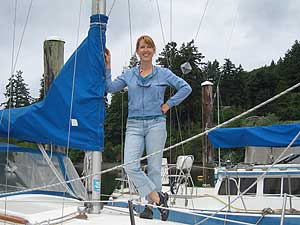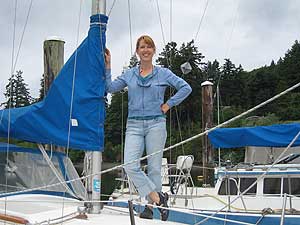Basic Sailing and Seamanship: Know Before You Go
Forget to check the weather forecast before you head out for a sail and you could be in for a rude awakening.
 It's a perfect day to go sailing. I know this because the skies are impossibly blue, the winds are blowing a steady northerly 8-10 knots and I am on jury duty/bedridden with a cold/obligated to write interesting and worthy columns for Boats.com/stuck in traffic. And if you think seaweed and barnacles create drag, don't even get me started on Son and Daughter and Their Lives and Hubby and His Work. It's a wonder I ever sail at all"¦which explains why I chose to ignore the weather: I had babysitting.
It's a perfect day to go sailing. I know this because the skies are impossibly blue, the winds are blowing a steady northerly 8-10 knots and I am on jury duty/bedridden with a cold/obligated to write interesting and worthy columns for Boats.com/stuck in traffic. And if you think seaweed and barnacles create drag, don't even get me started on Son and Daughter and Their Lives and Hubby and His Work. It's a wonder I ever sail at all"¦which explains why I chose to ignore the weather: I had babysitting.
Freed of cumbersome human ballast and early in the tenure of my captaincy, I thought I had a better chance of surviving a summer storm blowing in off the Pacific Ocean from the southwest than I did of finding babysitting on an alternate, better weather weekend. We cast off.
When the winds rose to 25 knots, Elation lay over on her port rail and the national weather service issued a small craft advisory, I felt slightly less sure. Hubby and I used a narrow, but practical skill set of hanging on, praying and swearing like longshoremen. In the way of the certain to die, we snickered at the tragic fate of the Weekend Babysitters soon to be promoted to Mom and Dad. All this, I thought, pulling my lips down over my teeth, because of the weather, or rather, all because of my lack of respect for the weather. These were my home waters, skies I had lived under my whole life, but until then I hadn't learned that what is uncomfortable weather on land, can be dangerous weather at sea. Adverse weather is the third leading cause of injuries at sea. I had a bruise on my butt to prove it.
For safety and comfort, know before you go. Check local radio, TV, newspapers, Intenet websites (www.weather.com, www.accuweather.com, www.nws.noaa.gov), the Weather Channel on TV, or tune into NOAA (National Oceanic and Atmospheric Administration) broadcasts, which report weather around the clock on radio channels: WX-1 (162.550 MHz), WX-2 (162.400 MHz), WX-3 (162.475 MHz),WX-4 (162.425 MHz), WX-5(162.450 MHz),WX-6 (162.500 MHz), WX-7 (162.525).
The taped messages are repeated every 4-6 minutes and updated several times a day; more if unusual weather develops. The Environment Canada Weather Department also provides continuous maritime weather coverage on WX-8 (161.650 MHz) or WX-9 (161.775 Mhz) on newer marine VHF radios. Keep monitoring the weather throughout the day.
Weather can change suddenly and can require a good skipper to change his/her plans. Poor weather is an excellent reason to stay home or stay put. Better to be tied up here wishing you were out there, than being out there and wanting to be tied up here.












